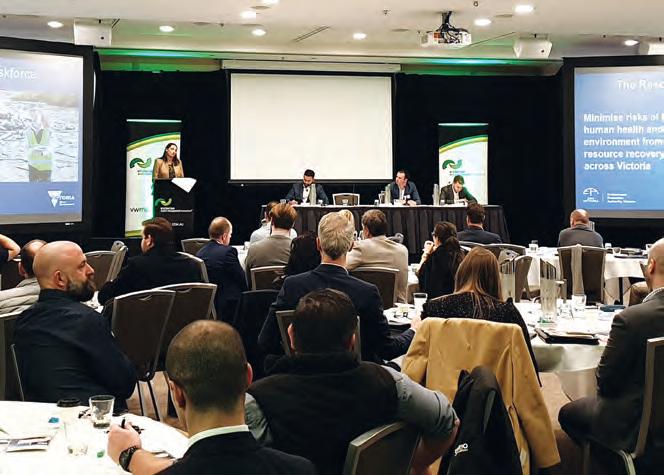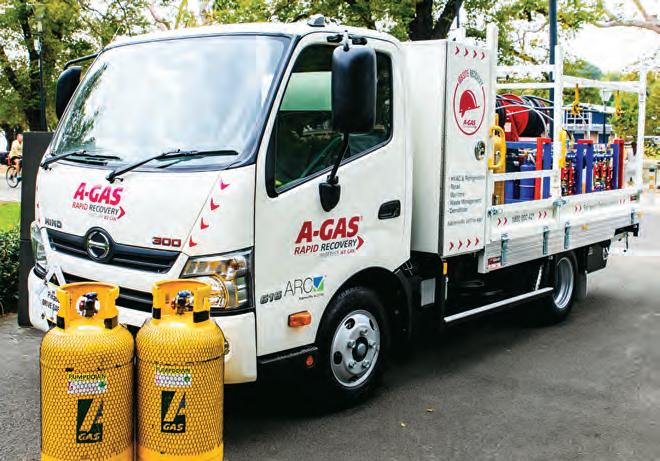
9 minute read
CRUSHING CONTAMINATION
Yarra City Council partnered with numerous stakeholders for its project.
WASTE MANAGEMENT REVIEW SPEAKS WITH CHRIS LEIVERS, YARRA CITY COUNCIL CITY WORKS AND ASSETS DIRECTOR, ABOUT THE COUNCIL’S ONGOING TRIAL OF KERBSIDE GLASS SEPARATION.
In the beginning of June of this year, 1300 Abbottsford households were greeted with new crates for their glass waste.
The crates were delivered to the inner north suburb of Melbourne as part of a kerbside glass collection trial, developed by the Yarra City Council.
The problem of crushed glass and contamination has been discussed at length in the resource recovery sector. However, as Waste Management Review reported in May, government action on the issue has been slow.
With funding from Sustainability Victoria, Yarra City Council is attempting to buck this trend by taking tangible steps to reduce contamination in the densely populated municipality. Another motivating issue is the lack of available landfill space in Victoria, particularly in metropolitan Melbourne.
Chris Leivers, Yarra City Council Director City Works and Assets, says recycling rates across Yarra are high, with the majority of residents being active recyclers. Despite this, Chris says recent changes to the recycling industry have promoted a proactive response from the council in an attempt to get ahead of potential future problems.
“Recent challenges in the waste and recycling industry will have an impact on all councils. A reduction in recycling processing in Melbourne will see additional pressures on the remaining processors,” Chris says.
“Making sure we minimise the amount of waste we send to landfill and improve the quality of recycling will ensure we continue to have a sustainable waste collection service into the future.”
The Yarra trial will run for 12 months and builds on a successful 2018 food and garden organics (FOGO) separation trial.
“The initial FOGO trial provided extremely useful data and information about the collection process and user behaviour, and identified that Yarra residents were willing to trial new ways and methods for kerbside recycling,” Chris says.
“This was very heartening for us and encouraged us to combine FOGO and glass separation in a larger trial area.”
Chris says results from the FOGO trial saw a 40 per cent diversion of waste from landfill, with current FOGO contamination rates now averaging less than one per cent.
The trial has been named the Yarra Waste Revolution and includes a targeted education and communications program.
“Recycling contamination is an ongoing issue for all councils, partly because, generally speaking, people do not have a good grasp on what is considered contamination when it comes to the kerbside recycling bin,” Chris says.
“We saw a great opportunity to make our recycled materials cleaner
and more valuable, which ensures they get a new life, while also sending less waste to landfill.
“The improved quality of the material will lead to higher value, increased market demand, market diversity and the development of domestic markets for recycled products.”
According to Chris, public response to the trial has been positive, with most residents supportive of the new service and the city’s efforts to reduce waste sent to landfill.
“In only a few short weeks, there has already been a dramatic improvement in the quality of the material being presented in glass recycling bins,” he says.
“The Yarra Waste Revolution is a major change for residents, so this is a phenomenal achievement by the community in a very short amount of time.”
To implement the trial, Yarra City Council has enlisted the support of the state government, Sustainability Victoria, RMIT University, Australian Paper Recovery, Four Seasons Waste and the Alex Fraser Group.
“Partnerships with industry and government agencies are critical to the success of this trial. We all need to work together to find solutions to the current recycling crisis,” Chris says.
“Our collection contractors, processors and industry partners

share our vision to find solutions to the recycling crisis, and are helping us collect and sort the materials here in Victoria.”
Chris says research partners have also helped council understand the lifecycle analysis of the city’s new collection model, and what that will mean for environmental outcomes.
“We couldn’t implement a trial without their participation and of course, the financial and technical support provided by our government partners,” he says.
“We are actively seeking out opportunities to work with all levels of government, and the waste industry, to deliver on a new circular economy approach to waste management.”
Following the trial, Chris says Yarra will consider expanding the service throughout the city.
“We have had the courage to explore alternative methods and innovate in order to develop a more sustainable kerbside model that transitions away from the current system which relies heavily on export markets,” Chris says.
“Our long-term ambition is to move our community towards producing zero waste by supporting circular economies and minimising the amount of waste produced.”
Chris adds that making sure Yarra residents are confident in the sustainability of their waste and recycling service is key to achieving viable and environmental outcomes.
“We recognise the changes we are implementing at a local level require buy-in and commitment from our residents, but are confident that we have the support of our community, who are very focused on sustainability,” he says.
“Our Yarra Waste Revolution trial to separate glass and food and organic waste only started in June this year, and while it is a bit premature to provide solid data or analysis, the early signs are very positive.”
Fashioning cotton gin
RESEARCHERS AT DEAKIN UNIVERSITY ARE TRANSFORMING COTTON GIN TRASH INTO A BIOPLASTIC FILM AND CREATING REUSE POTENTIAL FOR THE GLOBAL PROBLEM OF TEXTILE WASTE.
The fashion industry is one of the largest industrial polluters in the world, with the United Nations Environment Authority estimating that globally, the equivalent of one garbage truck of textiles is burned or sent to landfill each second.
Additionally, War on Waste calculations suggest 6000 kilograms of clothing is sent to landfill every 10 minutes. The ABC program attributes the scale of the problem largely to fast fashion.
The United Nations Environment Authority makes similar arguments, suggesting in a 2018 statement that recycling itself cannot fully address throwaway fashion culture. According to the authority, the number of times an individual garment is worn has declined by 36 per cent in the last 15 years.
Existing within the linear economy of make, use, dispose – throwaway fashion largely conforms to wider patterns of consumption. Dr Maryam Naebe of Deakin University’s Institute for Frontier Materials (IFM) is attempting to address this by studying ways to repurpose the textiles present in throwaway clothes.
Deakin’s IFM was established to develop scientific solutions to some of the major challenges facing waste generation. The institute attempts to do this via scientific and engineering innovation in material design and performance. The aim, according to Maryam, is to develop new materials and structures that are both affordable and possess low social cost.
The focus of Maryam’s research is sustainable approaches to value adding in natural fibres and textiles. Her most recent work centres around a common waste by-product of the textile industry, cotton gin.
Under Maryam’s lead, a team of scientists from IFM, including PhD candidate Abu Naser Md Ahsanul Haque and Associate Research Fellow

Deakin’s IFM was established to develop solutions to some of the major challenges facing waste generation. Dr Maryam Naebe.

Dr Rechana Remadevi, have developed a method of turning cotton gin trash into a biopolymer.
Cotton gin trash refers to cotton waste left over from the ginning process, which involves separating cotton from seeds. The resulting waste stream is a mix of seeds, stems, short fibres and other by-products.
As a senior researcher in fibre science and technology, Maryam noticed the huge reuse potential of cotton gin waste.
“About 29 million tonnes of cotton lint is produced each year, but up to a third of that ends up as cotton gin trash, where it’s then sent to landfill or burnt,” Maryam says.
“After group brainstorming, we realised cotton waste represented a major environmental problem, which created significant losses in material value.”
Maryam and her team’s method for transforming cotton gin trash involves dissolving the waste in environmentally
A team of IFM scientists at Deakin University have developed a method of turning cotton gin trash into a biopolymer.

friendly chemicals. The dissolved biomass then becomes an organic polymer, which can be re-cast into a useable bioplastic film.
Maryam says as a bioplastic, the organic polymer could be used in any throwaway application where synthetic plastics or films are already in use such as packaging, bale wrap and waterproofing supplies.
“Compared to synthetic plastics, our bioplastic is made without the need for toxic chemicals, which makes it safer and cheaper to produce at a mass scale,” Maryam says.
According to Maryam, the repurposed polymer can also be used as a fertiliser.
“The product also has the added bonus of contributing to a circular economy, as it can be placed in the soil to assist the regrowth of its original form,” Maryam says.
“The material is fabricated from a natural biodegradable cellulosic source and is therefore capable of being decomposed by bacteria or other living organisms.”
Maryam says in addition to presenting a sustainable solution to the problem of synthetic plastic, the process could also offer cotton farmers an additional source of income by generating a resale market for cotton waste.
While Maryam and her team feel positive about the scale up potential of their research, she says they are still in the beginning stages.
“Cotton gin trash is challenging to work with. A lot of waste streams are quite homogeneous, containing only one or two different materials,” Maryam says.
“Cotton gin waste however is heterogeneous, and consists of a lot of varied and unwanted material.”
Challenging waste stream aside, the process has already been successfully applied to create a membrane-like wastewater filter. Maryam says the filter has been used to remove dyes from textile manufacturing in wastewater, highlighting the circular aspect of the process.
According to Maryam, current testing shows the bioplastic filter has the same efficiency as charcoal, the current standard for the dye filtration process.
Despite working on the process for only 18 months, Maryam says researchers are now testing the method on other organic waste and fibre material.
She says testing has already produced demonstrated results with lemongrass and hemp, with good progress shown for barley straw and wheat straw.
Given exhibited results, Maryam says the process would not be difficult to upsell or commercialise. She says however, as with most research, that up scaling requires funding and support, both from industry and government.
“Research projects often get stuck in the infancy stage because they do not get the funding support required,” Maryam says.
“I would really like to see support for this kind of work, not just for my project, but all research that explores sustainable solutions for waste. If given the support to commercialise, work like this could create real change.”








